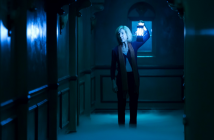Editor’s Notes: The following review is part of our coverage of the 2015 Vancouver International Film Festival. For more information on the festival visit viff.org and follow VIFF on Twitter at @viffest.
Mauro Herce’s first feature film, Dead Slow Ahead, is an abstract science-fiction mood-piece which takes place on a freighter between Ukraine and New Orleans. Herce journeyed on the freighter, “Fair Lady”, for two and a half months, shooting 14-16 hours a day to bring us a mostly silent, highly contemplative observational documentary about people living on a slow-moving (space)-ship which coasts through the seemingly endless beyond of the ocean.
A purely cinematic film, Dead Slow Ahead allows visual prowess to captivate the viewer. Through a languid rhythm and lethargic sense of time, the slow moving camera picks up on a seemingly imperceptible movement of objects, akin to the psychological sensibilities of those presumably working and wasting away on the ship. With many beautiful shots of the vast sea, expansive landscape, and complex ship interior, Dead Slow Ahead automatically cultivates a sense of being lost, and to a lesser extent of being cold. As the film pushes forwards into minor narratives about passengers on the freighter speaking to loved ones on a questionably operated phone system, its humanism finally transcends its otherwise impersonal and indifferent attitude, eliciting warmth and empathy from the viewers. This offers a striking contradiction to the many shots of machinery and industrial practice found in the film.
Authentically cinematic, Dead Slow Ahead allows the viewer to find his/her own journey through the film. Herce explains that he laid down stones, but it is for the viewer to find these stones, interpret their order, and travel along one’s own journey. It goes without mention that such a design invokes a great deal of imagination and spectatorial activity. As an avant-garde, mostly silent film, with long takes and deep space, Dead Slow Ahead is transformed by the audiences’ perceptions. The film challenges the viewer to find his/her own meaning as it slowly shifts between separate yet equally meaningful stills and episodes.
Throughout, there is a constant visual sense of quietude and darkness. It most palpably evokes feelings of the unknown and the beyond within. The eerie natural sounds of engines and ship movement, combined with electronic tones and some pitch-shifting, create in the film a harrowing soundtrack with a somewhat menacing atmosphere. This immediately complements Herce’s science fiction intentions, making the freighter appear uncanny, unfamiliar, and downright frightening at times. Through long takes, Herce leads us through a rather incredible journey, with never a feeling of stasis in spite of its constant feeling of presence.
Through long takes, Herce leads us through a rather incredible journey, with never a feeling of stasis in spite of its constant feeling of presence.




